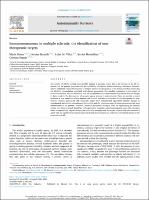Immunosenescence in multiple sclerosis: the identification of new therapeutic targets
Author
Date
2021-09Permanent link
https://hdl.handle.net/11351/7071DOI
10.1016/j.autrev.2021.102893
ISSN
1568-9972
WOS
000685341900001
PMID
34237417
Abstract
The number of elderly multiple sclerosis (MS) patients is growing, mainly due to the increase in the life expectancy of the general population and the availability of effective disease-modifying treatments. However, current treatments reduce the frequency of relapses and slow the progression of the disease, but they cannot stop the disability accumulation associated with disease progression. One possible explanation is the impact of immunosenescence, which is associated with the accumulation of unusual immune cell subsets that are thought to have a role in the development of an early ageing process in autoimmunity. Here, we provide a recent overview of how senescence affects immune cell function and how it is involved in the pathogenesis of autoimmune diseases, particularly MS. Numerous studies have demonstrated age-related immune changes in experimental autoimmune encephalomyelitis models, and the premature onset of immunosenescence has been demonstrated in MS patients. Therefore, potential therapeutic strategies based on rejuvenating the immune system have been proposed. Senolytics and regenerative strategies using haematopoietic stem cells, therapies based on rejuvenating oligodendrocyte precursor cells, microglia and monocytes, thymus cells and senescent B and T cells are capable of reversing the process of immunosenescence and could have a beneficial impact on the progression of MS.
Keywords
Autoimmunity; Immunosenescence; Multiple sclerosisBibliographic citation
Dema M, Eixarch H, Villar LM, Montalban X, Espejo C. Immunosenescence in multiple sclerosis: the identification of new therapeutic targets. Autoimmun Rev. 2021 Sep;20(9):102893.
Audience
Professionals
This item appears in following collections
- CEMCAT - Articles científics [161]
- HVH - Articles científics [4476]
- VHIR - Articles científics [1751]
The following license files are associated with this item:

 Private area
Private area Contact Us
Contact Us








